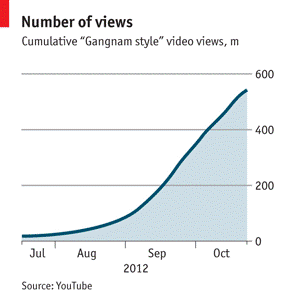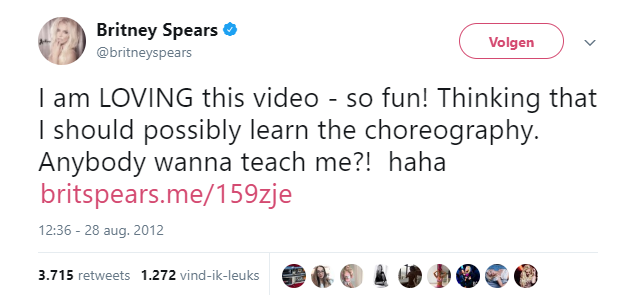
Overnight celebrities and virality
How does music get processed by the internet and lead to these so-called ‘overnight’ celebrities and number one songs? Uploading a video is not the only thing one has to do to become successful. It's all in the views and in the likes. But how does a certain music video get so much attention that it goes viral all over the world? In this article, I will examine these questions more in-depth, so we can have a clear understanding of how certain artists become so famous all over the world, even if it's i with just one song.
Celebrities on radio, television and YouTube
Nowadays, a singer’s or band’s success is not dependent on how many times their song gets played on the radio. Radio has become merely an instrument to make the artist and the songs they produce even more popular than they already were. In the decades following World War II, radio lost its dominant position (Castells, 2010). With the rise of the Web 2.0 all kinds of creative content sharing websites came along. Without a doubt YouTube, which was founded in 2005, is the most popular of them all.
"It was uploading more content per month than all three major U.S Television networks combined" (Van Dijck on YouTube)
YouTube grew up during a time when media were mostly ruled by television. Throughout the years, YouTube managed to position itself as the new television. As mentioned by Van Dijck (2013): ‘It was uploading more content per month than all three major U.S Television networks combined.’ I think this shows how much more accessible YouTube is, especially for upcoming artists, than television or radio networks.
You have to be asked to play on television or radio, or at least work really hard for your five minutes of fame on these networks, whereas on YouTube it's as simple as uploading your video wherever and whenever you want. This makes the medium much easier to access for people living in the margins, because the music industry is settled in big cities such as London and Los Angeles. These people may not be living in the center of the music industry, but globalization also has an effect on marginal regions in the world, meaning that these areas are getting more and more access to the Internet (Wang et al., 2013). We can then see how internet-based media, such as YouTube, can help these people to gain access to something like the music industry.
Virality and celebrities
First and foremost, I think it’s important to have a clear understanding of what ‘going viral’ means. The Urban Dictionary gives the following definition of going viral:
‘‘used in reference to Internet content which can be passed through electronic mail and social networking sites (Facebook, etc.): an image, video, or link that spreads rapidly through a population by being frequently shared with a number of individuals has 'gone viral'.’’
So ‘going viral’ in reference to the internet is something that came up in the last five to ten years. During this period, big parts of the world became highly interconnected with each other via the Internet. Globalization is of course not only something of the last ten years, but the last decade distinguishes itself by the rapid changes in technology and in the way we connect with each other.
The internet can be seen as the dominant infrastructure of this recent stage of globalization, creating cultural flows that spread all kinds of creative content (also music) all over the world with an immense speed. This creates a great opportunity for artists to become well-known in big parts of the world in a short period of time. Videos that go viral nowadays are not just ordinary videos. People want to be entertained and surprised. A simple music video will not do anymore. The video has to be extraordinary in some way, extremely funny or unpredictable. It needs to be something that catches people’s immediate attention; something that is worthy of sharing with their friends.
PSY
To illustrate the above I will look at a few cases of a music video gone viral. A very well-known example is ‘Gangnam Style’ by PSY. PSY is a South Korean singer, who mocks the lifestyle of rich South Koreans. In the video, you see PSY dancing in a rather extraordinary manner, the so-called horse dance. The images are moving quickly, never leaving any room for a dull moment. The video was released on July 15th 2012. At the end of September 2012 it had over 300 million views and it was listed in the Guinness Book of Records as the most liked YouTube video. Today, it has almost made it to three billion views on YouTube. In Figure 1, you can see how rapidly the views increased after two months.

figure 1
Two factors contributed to the big hype surrounding Gangnam Style. Firstly, the South Korean record label YG Entertainment did a lot of research on how to make this song both a top hit in South Korea, as well as in the UK and the US. Strategic marketing is of course helpful for gaining more success, especially when a video has just been uploaded. YG entertainment already obtained a large engaged audience beforehand, mostly via their YouTube platform and social media accounts, so when this interesting and catchy song came along, it was quickly seen by this big audience (Jones, 2012).
Secondly, what ultimately drove the video to its success, is the sharing of the video after its quick uptake. This was possible due to how much value we attach to social media nowadays and how we are connected to each other via these media. The video became a trending topic on Twitter, a micro-blogging service.
Moreover, a lot of celebrities tweeted about the video, for example Britney Spears (figure 2). With almost 56 million followers, she reaches a very big audience from all over the world. But her audience does not consist of only her followers, who get to see her tweet about Gangnam Style in their feeds. Her followers retweeted the tweet almost 4000 times, meaning that a lot of other Twitterers, who do not follow Britney, got to hear about this video (Twitter, 2012). This sharing continues among these other people and so on, resulting in the video circulating over the Internet on all kinds of social platforms all over the world. Nobody wants to miss out on this new phenomenon.


figure 2
After all this sharing, the song was also played by a lot of radio stations. Funnily enough, the lyrics of the song are almost completely sung in Korean, except for two sentences: 'Gangnam Style' and 'Sexy lady'. This gives the song a bit of an international touch. Almost no one, except Korean-speaking people, understood what PSY was singing about. This did not stop the song from remaining in the Dutch Top 40 for 23 weeks for example (from 1 September, 2012), and even making it to the number one position, where it stayed for two weeks (Top40, 2012).
When a video goes viral, it is almost inevitable that parodies show up on the internet as well. Zwarte Pieten Style produced by Party Piet Pablo, is an example of this. This was a new version of Gangnam Style, but in a localized manner. It is about the Dutch traditional event Sinterklaas. In this way, world-famous songs are being recreated for a new audience in a particular area in the world, adapting it to the culture of that area.
“I didn’t expect anything like this. So what can I say? Everything moves way too fast” (PSY on Gangnam Style)
PSY became a very well-known artist and it only took him one song and a few weeks, which resulted in a big fan base for his next songs and a profit of millions of dollars (McIntyre, 2017). I think this shows how much and how quickly the internet and its social media platforms influence what we listen to. As PSY (2012) said in an interview with the New York Times: “I didn’t expect anything like this. So what can I say? Everything moves way too fast.”
Unfortunately, PSY's second song Gentlemen M/V (2013) was not such a success compared to Gangnam Style. Of course, it is very difficult, if not impossible, to create a video as good and creative as Gangnam Style. Gentlemen M/V is a bit repetitive in that sense and that is something that will not catch people's attention. It was not as new anymore as was Gangnam Style when it came out; not new enough to go viral.
Susan Boyle
Another example I would like to elaborate on is the Scottish singer Susan Boyle. While we may not hear much about her nowadays and you probably forgot about her existence, she became world-famous with her audition in Britain’s Got Talent. In 2009, Susan made her entrance on stage. She was wearing no make-up, had grey hair, wore outdated and unflattering clothing and she was quite old for a contestant, as she was 48 at the time. These were kind of deal breakers for everyone who was watching the show. You can imagine that the judges were not too excited to see her appearing on stage and did not expect too much of her performance. But the moment she opened her mouth, Simon Cowell and the rest of the judges where completely astonished. And so was Great-Britain. With an unbelievable voice, she went through to the next round.
This one audition was enough to make Susan Boyle an overnight sensation. Videos of her audition ended up on YouTube immediately after the show, resulting in more than 100 million views in less than three weeks. So not only the audience of Great-Britain’s national television could enjoy this amazing audition, but the whole world was able to within a few hours, if not minutes, after it was broadcasted. However, not only the Internet was full with Susan Boyle, the newspapers also featured various articles about her. The older generation is normally not very fond of websites like YouTube, or even the internet at all. So they will not notice most videos or singers that go viral. However, most of the older generation is still loyal to their newspaper. This means that they also came accross articles about Susan Boyle and if curiosity took control of them, the only thing left to do was to look her up on the Internet. This is in contrast with Gangnam Style, which was mainly an internet sensation and did not appear much outside of it, expect for on the radio.
"She was like a virus that spread across the world in a nanosecond" (Elaine Paige on Susan Boyle)
At the end of 2009, Susan Boyle’s audition was the most-watched video on YouTube (The Standard, 2009). But of course, Susan’s audition was also shared via other social media platforms. Actress Demi Moore and her famous husband Ashton Kutcher used Twitter to discuss Boyle's performance (figure 3).

figure 3
At that time, they had over one million followers. Of course, the news spread like a wildfire here as well and Susan Boyle became a trending topic. Here again, we see big influencers on social media contributing to the ‘virality’ of a video. It seemed like the winner of the contest was already decided upon on social media. Unfortunately, she ended up in second place in the finals, but that did not even matter anymore. Susan got all the social attention that was needed to make a celebrity of someone. As Susan’s biggest idol Elaine Paige said in an interview: "She was like a virus that spread across the world in a nanosecond." After the contest, she released an album that broke records in charts and sales in several countries (The Guardian, 2009). Without her partaking in the contest, her beautiful voice would probably still be left to uncover today.
Celebreties and phatic communication
The examples described above show how we are living in a transnational world today, in which dynamicity and unpredictability are keywords (Castells, 2010). Cultural success does not stay within national borders, but spreads throughout the whole world via social media platforms that contribute greatly to the generation of this success. Gangnam Style is not only a South Korean success and Susan Boyle is not limited to performances in Great Britain. A national success becomes a global success. Through the internet, people are entertained with all kinds of (music) videos that they come across, because someone they know or follow liked and shared them.
People on social media platforms find it important to not miss out on this ‘virality’. They want to be part of this ‘community’ that likes and shares posts by other persons. They want to be connected to others, even if this happens through so-called ‘phatic communion’: the sharing of ‘empty’ messages containing no relevant content. You can see this when you look at the reactions placed on a video. They are placed so that the commenters become part of it, not because they have anything important to mention (Blommaert & Varis, 2015).
I think it is important to mention that what characterizes society nowadays is the short attention span we have. Every day, videos go viral, and we cannot keep up with these continuous and dynamic flows of content. This often results in fame being of short duration and songs being quickly forgotten. PSY and Susan Boyle have not been in the spotlights for a long time now. People moved on to other artists and in a month it will be someone else again who will be in the middle of attention. A singer who only recently became famous cannot afford to take a year off. Their fame will vanish as quickly as their music video was uploaded on YouTube.
References
Anonymous (2009). Susan Boyle audition tops YouTube most-watched videos chart. Evening Standard. (Last retrieved on November 1, 2017).
Blommaert, J. & P. Varis (2015). Enoughness, accent and light communities: Essays on contemporary identities. Tilburg University, The Netherlands.
Castells, M. (2010). The Rise of the Network Society. West-Sussex, United Kingdom: Blackwell.
Edwards, L. (2012). How Did Gangnam Style Go Viral? SocialMediaToday. (Last retrieved on November 1, 2017).
Hyde, M. (2010). What Elaine Paige really thinks of Susan Boyle. The Guardian. (Last retrieved on November 1, 2017).
Jones, G. (2012). How did gangnam style go viral online? (Last retrieved on November 1, 2017).
K.N.C. (2012). The rise and rise of PSY. The Economist. (Last retrieved on November 1, 2017).
McIntyre, H. (2017). Psy's 'Gangnam Style' Finally Reaches 3 Billion Views On YouTube. (Last retrieved on December 11, 2017)
Michaels, S. (2009). Susan Boyle reaches No 1 with record-breaking debut album. The Guardian. (Last retrieved on November 1, 2017).
Ryzik, M. (2012). His Style Is Gangnam, and Viral Too, The New York Times. (Last retrieved on December 11, 2017).
Top 40 (2012). Week 31. (Last retrieved on November 1, 2017).
Van Dijck, J. (2014). The Culture of Connectivity, A Critical History of Social Media. New York, NY: Oxford University Press.